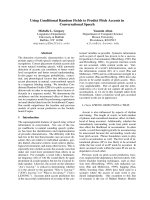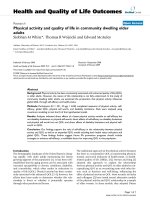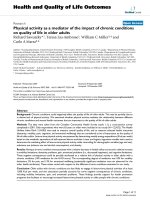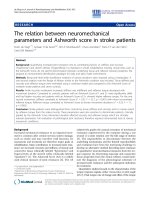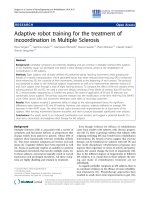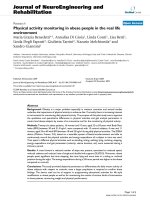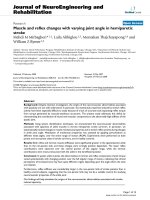báo cáo hóa học:" Physical activity is related to quality of life in older adults" ppt
Bạn đang xem bản rút gọn của tài liệu. Xem và tải ngay bản đầy đủ của tài liệu tại đây (245.72 KB, 6 trang )
BioMed Central
Page 1 of 6
(page number not for citation purposes)
Health and Quality of Life Outcomes
Open Access
Research
Physical activity is related to quality of life in older adults
Luke S Acree
1
, Jessica Longfors
1
, Anette S Fjeldstad
1
, Cecilie Fjeldstad
1
,
Bob Schank
1
, Kevin J Nickel
1
, Polly S Montgomery
2
and
Andrew W Gardner*
2
Address:
1
Department of Health and Exercise Science, University of Oklahoma, Norman, OK, USA and
2
CMRI Metabolic Research Center,
University of Oklahoma Health Sciences Center, 1122 N.E. 13th Street, ORI-W 1400, Oklahoma City, OK 73117, USA
Email: Luke S Acree - ; Jessica Longfors - ; Anette S Fjeldstad - ;
Cecilie Fjeldstad - ; Bob Schank - ; Kevin J Nickel - ;
Polly S Montgomery - ; Andrew W Gardner* -
* Corresponding author
Abstract
Background: Physical activity is associated with health-related quality of life (HRQL) in clinical
populations, but less is known whether this relationship exists in older men and women who are
healthy. Thus, this study determined if physical activity was related to HRQL in apparently healthy,
older subjects.
Methods: Measures were obtained from 112 male and female volunteers (70 ± 8 years, mean ±
SD) recruited from media advertisements and flyers around the Norman, Oklahoma area. Data was
collected using a medical history questionnaire, HRQL from the Medical Outcomes Survey short
form-36 questionnaire, and physical activity level from the Johnson Space Center physical activity
scale. Subjects were separated into either a higher physically active group (n = 62) or a lower
physically active group (n = 50) according to the physical activity scale.
Results: The HRQL scores in all eight domains were significantly higher (p < 0.05) in the group
reporting higher physical activity. Additionally, the more active group had fewer females (44% vs.
72%, p = 0.033), and lower prevalence of hypertension (39% vs. 60%, p = 0.041) than the low active
group. After adjusting for gender and hypertension, the more active group had higher values in the
following five HRQL domains: physical function (82 ± 20 vs. 68 ± 21, p = 0.029), role-physical (83
± 34 vs. 61 ± 36, p = 0.022), bodily pain (83 ± 22 vs. 66 ± 23, p = 0.001), vitality (74 ± 15 vs. 59 ±
16, p = 0.001), and social functioning (92 ± 18 vs. 83 ± 19, p = 0.040). General health, role-
emotional, and mental health were not significantly different (p > 0.05) between the two groups.
Conclusion: Healthy older adults who regularly participated in physical activity of at least
moderate intensity for more than one hour per week had higher HRQL measures in both physical
and mental domains than those who were less physically active. Therefore, incorporating more
physical activity into the lifestyles of sedentary or slightly active older individuals may improve their
HRQL.
Published: 30 June 2006
Health and Quality of Life Outcomes 2006, 4:37 doi:10.1186/1477-7525-4-37
Received: 16 January 2006
Accepted: 30 June 2006
This article is available from: />© 2006 Acree et al; licensee BioMed Central Ltd.
This is an Open Access article distributed under the terms of the Creative Commons Attribution License ( />),
which permits unrestricted use, distribution, and reproduction in any medium, provided the original work is properly cited.
Health and Quality of Life Outcomes 2006, 4:37 />Page 2 of 6
(page number not for citation purposes)
Background
Successful aging encompasses multiple dimensions of
health, including physical, functional, social, and psycho-
logical well-being [1]. Maintaining a high level of quality
of life into advanced age is a growing public health con-
cern as the older adult population continues to increase.
In fact, one of the primary goals of Healthy People 2010
is to improve both the quality and the number of years of
healthy life [2]. Quality of life is frequently measured in
investigations to evaluate the health of both clinical and
general populations [3], and is therefore termed health-
related quality of life (HRQL). Core dimensions in a
HRQL assessment include physical and social function-
ing, emotional well-being, role activities, and individual
health perceptions [3,4].
Physical activity has a beneficial effect on HRQL in
patients with depression [5], intermittent claudication
[6], coronary disease [7], and multiple organ dysfunctions
[8]. In 2001, a review concluded that physical activity,
often in the form of endurance and/or resistance training
exercise, was positively associated with HRQL, regardless
of age, health and activity status [3]. Data from the 2001
Behavioral Risk Factor Surveillance System, consisting of
a large sample with a wide range of demographic and
physical characteristics, found that people attaining the
recommended amounts of physical activity had higher
HRQL than their less active counterparts [9]. However,
few of these studies have addressed the relationship
between physical activity and all domains of HRQL in
healthy, older adults.
In aging populations, the health benefits from physical
activity (i.e., decreased risk for cardiovascular disease, dia-
betes, hypertension, cancer, and all-cause mortality) are
well-known [10-12]. However, it is not clear whether
physical activity improves specific domains of HRQL. A
recent report found that physical activity was associated
with less bodily pain in a carefully selected group of sed-
entary older adults who had either high normal blood
pressure or mild hypertension, but who were free of clin-
ical manifestations of chronic diseases [13]. The lack of
association between physical activity and the other
domains of HRQL may have occurred due to the narrow
range in physical activity level of this sedentary cohort.
Thus, studying older adults who are physically active in
addition to those who are sedentary may be necessary to
delineate the association between physical activity and
HRQL.
The main purpose of this study was to determine if phys-
ical activity was associated with HRQL in apparently
healthy, older subjects.
Methods
Subjects
Recruitment
A total of 112 subjects (63 females and 49 males) between
the ages of 60 and 89 years were recruited from newspaper
advertisements and media flyers posted around the Nor-
man, OK area. Prior to investigation, each subject com-
pleted a written informed consent. The study was
conducted with the approval of the Institutional Review
Board at the University of Oklahoma.
Inclusion and exclusion criteria
Men and women who were 60 years of age and older were
included in this study. Participants with a history of overt
cardiovascular disease (i.e., myocardial infarction, stroke,
congestive heart failure, lower extremity revascularization,
and peripheral arterial disease confirmed by an ankle/bra-
chial index < 0.90) or chronic obstructive pulmonary dis-
ease were excluded because of the possible confounding
influences that cardiovascular diseases may have on both
physical activity and HRQL.
Measurements
Demographic measures and medical history
A detailed, medical history was obtained from each partic-
ipant. The medical history addressed all of the aforemen-
tioned exclusion criteria, as well as other comorbid
conditions such as hyperlipidemia, dyspnea, diabetes,
arthritis, hypertension. Height was measured using a sta-
diometer, with the measurement taken to the nearest 0.1
cm. Weight was measured using a balance scale, with the
measurement taken to the nearest 0.1 kg. Height and
weight measurements were then used to calculate body
mass index (BMI): [BMI = (weight in kilograms)/(height
in meters)
2
]. Waist-to-hip ratio was measured with a
Gulick measuring tape, with a horizontal measure at both
the waist and hip sites, taken to the nearest 0.1 cm. Blood
pressure and heart rate were measured with a Critikon
automated Dinamap sphygmomanometer following 10
minutes of supine rest, and ankle/brachial index was
obtained by Doppler ultrasound [6].
Physical activity
Subjects were divided into either a lower or higher physi-
cal activity group based on their score on the Johnson
Space Center physical activity scale, as previously
described [14]. This scale consists of the following scores:
0 = avoid physical activities, 1 = light physical activities
done occasionally, 2 = moderate physical activities done
regularly for less than one hour per week, 3 = moderate
physical activities done regularly for more than one hour
per week, 4 = heavy physical activities done regularly for
less than 30 minutes per week, 5 = heavy physical activi-
ties done regularly between 30 and 60 minutes per week,
6 = heavy physical activities done regularly between 1 and
Health and Quality of Life Outcomes 2006, 4:37 />Page 3 of 6
(page number not for citation purposes)
3 hours per week, and 7 = heavy physical activities done
regularly for more than 3 hours per week. Subjects were
asked to select the number that best corresponded to their
physical activity level during the previous month. Subjects
who had a score of 2 or below were included in the lower
physical activity group (n = 50), whereas subjects who had
a score of 3 or above were included in the higher physical
activity group (n = 62). In this likert scale, those subjects
who scored less than 3 were far below the minimum rec-
ommendation of physical activity from the Center for Dis-
ease Control and the American College of Sports Medicine
[15], whereas those who scored 3 or higher were closer to
meeting this recommendation or exceeded it. The John-
son Space Center physical activity scale is a valid measure
of peak oxygen uptake [14] and monitored physical activ-
ity (r = 0.44, p < 0.001) in older adults [16]. Furthermore,
the prediction of peak oxygen uptake by using the John-
son Space Center physical activity scale has been validated
in gender-specific models, as well as in a generalized
model which included both men and women [17].
Health-related QoL
The Medical Outcomes Survey Short Form-36 (MOS SF-
36) questionnaire was administered to assess HRQL over
the previous four weeks [18]. The MOS SF-36 is a widely
used, reliable, and valid criterion measure of HRQL in
numerous populations [3]. The MOS SF-36 questionnaire
has 36 questions that are scored to measure eight domains
of HRQL pertaining to both physical and mental health
[19,20]. The domains of physical functioning, role limita-
tions due to physical health (role-physical), bodily pain,
and general health comprised the physical component of
HRQL, whereas the domains of vitality, social function-
ing, role limitations due to emotional health (role-emo-
tional), and mental health comprised the mental
component of HRQL [19]. Each domain was scored using
a scale ranging between 0 and 100, with higher scores
indicating a higher HRQL than lower scores. Internal con-
sistency of the MOS SF-36 is good, with Cronbach's alpha
ranging from 0.76 to 0.90 for all domains of the question-
naire [21].
Statistical analysis
SPSS version 11.5 for Windows was used to analyze all
data. Unpaired t-tests were performed on continuous var-
iables to determine differences in HRQL and demo-
graphic measurements between the high active and low
active groups. Chi-square tests were performed on cate-
gorical variables to determine differences between the two
groups in the prevalence of comorbid conditions
obtained from the medical history. Analysis of covariance
was performed to determine whether differences in HRQL
measurements between the high active and low active
groups persisted after adjusting for group differences in
demographic and comorbid measures. Statistical signifi-
cance was set at P = 0.05. Measurements are reported as
mean ± standard deviation (SD).
Results
The baseline characteristics of the subjects in the two
physical activity groups are displayed in Table 1. All values
were similar (p > 0.05) between the two groups, except for
the gender composition and the prevalence of hyperten-
sion. The group reporting lower physical activity had a
greater proportion of females (p = 0.033) and a greater
prevalence of hypertension (p = 0.041) than the group
reporting higher physical activity. Both groups consisted
largely of Caucasian subjects (p > 0.05).
All eight domains of HRQL were higher (p < 0.05) in the
high active group than the low active group (Table 2).
After adjusting for gender and hypertension (Table 3), the
following five domains of HRQL remained higher in the
high active group: physical functioning (p = 0.029), role-
physical (p = 0.022), vitality (p = 0.001), social function-
ing (p = 0.04) and bodily pain (0.001). The domains of
Table 1: Subject characteristics between those who have lower and higher levels of physical activity. Values are means (SD) or
percentages.
Variables Lower Physical Activity
Group (n = 50)
Higher Physical Activity
Group (n = 62)
Test Statistic* P Value
Age (yrs) 70 (8) 69 (8) 0.36 0.717
Weight (kg) 76.8 (14.8) 78.1 (14.4) 0.49 0.626
Body Mass Index (kg/m
2
) 28.6 (5.6) 27.2 (4.9) 1.00 0.320
Waist-to-Hip Ratio 0.84 (0.09) 0.87 (0.10) 1.25 0.215
Gender (% Female) 72 44 4.55 0.033
Race (% Causasian) 92 94 1.46 0.227
Hypertension (%) 60 39 4.18 0.041
Hyperlipidemia (%) 34 32 < 0.01 0.979
Diabetes (%) 14 13 < 0.01 0.963
Dyspnea (%) 36 23 1.39 0.238
Arthritis (%) 68 53 1.42 0.234
* t-scores and chi-square scores.
Health and Quality of Life Outcomes 2006, 4:37 />Page 4 of 6
(page number not for citation purposes)
role limitations due to emotional health, mental health,
and general health were no longer different (p > 0.05)
between the two activity groups after adjusting for gender
and hypertension.
Discussion
The primary findings of this investigation were that
healthy older adults who participated in regular physical
activity of at least moderate intensity for more than one
hour per week had higher values in all eight domains of
HRQL than those who were less physically active. After
adjustment for gender and hypertension, the group
reporting higher physical activity had higher values in five
of the domains of HRQL than the group with lower phys-
ical activity.
Several studies have shown that organized, high-intensity
exercise regimens can benefit HRQL in both diseased
[3,5,22-24] and healthy populations [25,26]. Our study
extends these findings by showing that the less-structured
and less-intense nature of physical activity is positively
related to multiple domains of HRQL in healthy, older
adults. An active lifestyle preserves physical function in
older adults [27], which may possibly contribute to higher
levels of HRQL scores in domains related to physical
health. In a carefully selected group of sedentary older
adults, habitual physical activity level was associated with
less bodily pain, but not with the other domains of HRQL
[13]. It is possible that the range in physical activity level
was too narrow within the sedentary older adults, thereby
limiting the influence that physical activity may have
exerted on HRQL domains. The present study supports
this notion, as the group having higher physical activity
levels had greater values in all of the domains of HRQL
related to physical health (i.e., physical function, role lim-
itations due to physical health, bodily pain, and general
health) than their more sedentary counterparts.
After adjusting for group differences in gender composi-
tion as well as the prevalence of hypertension, all of the
HRQL measures in the physical health domain remained
higher in the more physically active group except for the
measure of general health. This suggests that the HRQL
domains of physical function, role limitations due to
physical health, and bodily pain are positively associated
with physical activity, independent of hypertension and
gender. In contrast, group differences in hypertension and
gender explained the lower scores in general health in
those with lower physical activity. The lack of an inde-
pendent relationship between physical activity level and
Table 2: Health-related quality of life measures in subjects who have lower and higher levels of physical activity. Values are means
(SD).
Variables Lower Physical Activity
Group (n = 50)
Higher Physical Activity
Group (n = 62)
Test Statistic* P Value
Physical Function 65 (24) 83 (16) 2.94 0.004
Role-Physical 60 (39) 85 (25) 2.75 0.007
Role-Emotional 71 (36) 92 (24) 2.29 0.024
Vitality 56 (19) 76 (14) 3.38 < 0.001
Mental Health 77 (16) 84 (12) 2.17 0.032
Social Function 81 (18) 93 (16) 2.08 0.040
Bodily Pain 64 (26) 84 (16) 3.17 0.002
General Health 62 (18) 75 (15) 2.47 0.015
* t-scores.
Table 3: Adjusted health-related quality of life measures in subjects who have lower and higher levels of physical activity. Values are
means (SD).
Variables Lower Physical Activity
Group (n = 50)
Higher Physical Activity
Group (n = 62)
Test Statistic* P Value
Physical Function 68 (21) 82 (20) 4.90 0.029
Role-Physical 61 (36) 83 (34) 5.40 0.022
Role-Emotional 75 (33) 89 (31) 3.17 0.078
Vitality 59 (16) 74 (15) 11.44 < 0.001
Mental Health 78 (14) 83 (13) 2.72 0.102
Social Function 83 (19) 92 (18) 4.32 0.040
Bodily Pain 66 (23) 83 (22) 11.44 < 0.001
General Health 65 (16) 73 (15) 2.61 0.109
Values were adjusted for gender and hypertension. * t-scores.
Health and Quality of Life Outcomes 2006, 4:37 />Page 5 of 6
(page number not for citation purposes)
the domain of general health agrees with the observation
in sedentary older adults [13], but contradicts other
reports that found improvements in perceived health sta-
tus following an exercise program [28,29].
In addition to the physical health measures of HRQL, a
physically active lifestyle is positively associated with
components of mental health in older adults as well [3].
The present investigation found that the group with
higher physical activity levels had higher values in all of
the domains of HRQL related to mental health (i.e., vital-
ity, social functioning, role limitations due to emotional
health, and mental health) than their more sedentary
counterparts. After adjusting for group differences in gen-
der composition as well as the prevalence of hyperten-
sion, the mental health domains of vitality and social
functioning remained higher in the more physically active
group, whereas the role-emotional and mental health
domains were no longer different between the two
groups. Thus, higher levels of physical activity are related
to higher scores of vitality and social functioning inde-
pendent of hypertension and gender. The association
between physical activity on mental health domains of
vitality and social functioning may be mediated through
differences in maximal oxygen uptake and in body fat per-
centage [13].
The lack of an independent relationship between physical
activity level and the domains of mental health and role
limitations due to emotional health found in the present
investigation is supported by previous studies [13,26,30].
Collectively, these results suggest that physical activity has
minimal impact on mental health and role limitations
due to emotional health. However, our findings show that
hypertension and gender have a more influential role on
these HRQL domains, which agree with previous reports
that individuals with hypertension have lower values of
HRQL in both a general population [31], and in cardiac
patients [32]. It is possible that individuals who have been
diagnosed with hypertension have a greater awareness
through medical counseling about the increased cardio-
vascular health risk associated with poorly controlled
blood pressure, resulting in concern about their health
status. Less is known about the influence of gender on
HRQL. Repetto et al. reported that, as a result of a longer
life expectancy, women are more apt to live alone and to
receive assistance from others for daily life activities [33],
which may influence their perception of HRQL. In addi-
tion to these findings, the present study emphasizes the
need to more clearly define the independent role that
hypertension and gender have on HRQL.
The main limitation of this study is the utilization of a
cross-sectional design, which does not allow a true causal
relationship to be established. Although physical activity
may affect HRQL, it is also possible that HRQL has an
impact on physical activity. It should be noted that our
recruitment methods were biased toward older individu-
als who responded to newspaper advertisements and fly-
ers posted in public facilities. Additionally, the Johnson
Space Center questionnaire determines an overall level of
physical activity without quantifying various types of
physical activity. However, the questionnaire does con-
tain questions about sweating that coincide with light,
moderate, and heavy activity, thereby increasing the like-
lihood for more accurate reporting. Another limitation is
that both physical activity and HRQL measures were
obtained by self-report. However, this limitation is mini-
mized because both instruments are valid and reliable
[14,18], and are simple for health professionals to admin-
ister. Finally, the current study used a relatively small con-
venience sample of healthy older adults who had few co-
morbid conditions. Consequently, the findings of this
study cannot be generalized to older adults who have
more serious health conditions.
Conclusion
In summary, healthy older adults who participated in reg-
ular physical activity of at least moderate intensity for
more than one hour per week had higher values in all
eight domains of HRQL than those who were less physi-
cally active. After adjustment for gender and hyperten-
sion, the group reporting higher physical activity had
higher values in five of the domains of HRQL than the
group with lower activity. These findings give added
strength to previous observations that higher levels of
physical activity may improve HRQL [3,9,13]. Therefore,
incorporating more than one hour of moderate-intensity
physical activity each week into the lifestyles of older indi-
viduals who are either sedentary or slightly active may
improve their HRQL.
Competing interests
The author(s) declare that they have no competing inter-
ests.
Authors' contributions
LSA acquired data, assisted with statistical analyses and
their interpretation, and drafted and revised the manu-
script. JL conceived and designed the study, acquired data,
performed statistical analyses, and drafted the manu-
script. BS and PSM recruited subjects and revised the man-
uscript. ASF, CF, KJN acquired data and revised the
manuscript. AWG conceived and designed the study,
assisted with statistical analyses and their interpretation,
and drafted and revised the manuscript. All authors read
and approved the final manuscript.
Acknowledgements
Andrew W. Gardner, Ph.D., was supported by grants from the National
Institute on Aging (NIA) (R01-AG-16685), by a University of Oklahoma
Publish with BioMed Central and every
scientist can read your work free of charge
"BioMed Central will be the most significant development for
disseminating the results of biomedical research in our lifetime."
Sir Paul Nurse, Cancer Research UK
Your research papers will be:
available free of charge to the entire biomedical community
peer reviewed and published immediately upon acceptance
cited in PubMed and archived on PubMed Central
yours — you keep the copyright
Submit your manuscript here:
/>BioMedcentral
Health and Quality of Life Outcomes 2006, 4:37 />Page 6 of 6
(page number not for citation purposes)
Research Council grant, and by the University of Oklahoma Health Sciences
Center General Clinical Research Center grant (M01-RR-14467) spon-
sored by the National Center for Research Resources from the National
Institutes of Health.
References
1. Phelan EA, Anderson LA, LaCroix AZ, Larson EB: Older adults'
views of "successful aging" – how do they compare with
researcher's definitions? J Am Geriatr Soc 2004, 52:211-216.
2. U.S. Department of Health and Human Services: Healthy People
2010: Understanding and Improving Health. 2nd edition.
Washington, D.C.: U.S. Government Printing Office; 2000:8-11.
3. Rejeski WJ, Mihalko SL: Physical activity and quality of life in
older adults. J Gerontol A Biol Sci Med Sci 2001, 56:23-35.
4. Shumaker SA, Anderson RT, Czajkowski SM: Psychological tests
and scales. In Quality of life assessment in clinical trials Edited by:
Spilker B. New York: Raven Press; 1990:95-113.
5. Singh NA, Clements KM, Fiatarone MA: A randomized controlled
trial of progressive resistance training in depressed elders. J
Gerontol A Biol Sci Med Sci 1997, 52:M27-35.
6. Gardner AW, Killewich LA, Montgomery PS, Katzel LI: Response to
exercise rehabilitation in smoking and nonsmoking patients
with intermittent claudication. J Vasc Surg 2004, 39:531-538.
7. Lavie CJ, Milani RV: Effects of cardiac rehabilitation, exercise
training, and weight reduction on exercise capacity, coro-
nary risk factors, behavioral characteristics, and quality of
life in obese coronary patients. Am J Cardiol 1997, 79:397-401.
8. Wehler M, Geise A, Hadzionerovic D, Aljukic E, Reulbach U, Hahn
EG, Strauss R: Health-related quality of life of patients with
multiple organ dysfunctions: individual changes and compar-
ison with normative population. Crit Care Med 2003,
31:1094-1101.
9. Brown DW, Balluz LS, Heath GW, Moriarty DG, Ford ES, Giles WH,
Mokdad AH: Associations between recommended levels of
physical activity and health-related quality of life: Findings
from the 2001 Behavioral Risk Factor Surveillance System
(BRFSS) survey. Prev Med 2003, 37:520-528.
10. Lim K, Taylor L: Factors associated with physical activity
among older people – a population-based study. Prev Med
2005, 40:33-40.
11. Siscovick DS, Fried L, Mittelmark M, Rutan G, Bild D, O'Leary DH:
Exercise intensity and subclinical cardiovascular disease in
the elderly. The Cardiovascular Health Study.
Am J Epidemiol
1997, 145:977-986.
12. DiPietro L: Physical activity in aging: changes in patterns and
their relationship to health and function. J Gerontol A Biol Sci
Med Sci 2001, 56:13-22.
13. Stewart KJ, Turner KL, Bacher AC, DeRegis JR, Sung J, Tayback M,
Ouyang P: Are fitness, activity, and fatness associated with
health-related quality of life and mood in older persons? J
Cardiopulm Rehabil 2003, 23:115-121.
14. Jackson AS, Blair SN, Mahar MT, Wier LT, Ross RM, Stuteville JE:
Prediction of functional aerobic capacity without exercise
testing. Med Sci Sports Exerc 1990, 22:863-870.
15. Pate RR, Pratt M, Blair SN, Haskell WL, Macera AA, Bouchard C,
Buchner D, Ettinger W, Health GW, King A, Kriska A, Leon AS, Mar-
cus BH, Morris J, Paffenbarger RS Jr, Patrick K, Pollock ML, Rippe JM,
Sallis J, Wilmore JH: Physical activity and public health: A rec-
ommendation from the Centers for Disease Control and
Prevention and the American College of Sports Medicine.
JAMA 1995, 273:402-407.
16. Sieminski DJ, Cowell LL, Montgomery PS, Pillai SB, Gardner AW:
Physical activity monitoring in patients with peripheral arte-
rial occlusive disease. J Cardiolpulm Rehabil 1997, 17:43-47.
17. Heil DP, Freedson PS, Ahlquist LE, Price J, Rippe JM: Nonexercise
regression models to estimate peak oxygen uptake. Med Sci
Sports Exerc 1995, 27:599-606.
18. Lyons RA, Perry HM, Littlepage BN: Evidence for the validity of
the Short-form 36 Questionnaire (SF-36) in an elderly popu-
lation. Age Ageing 1994, 23:182-184.
19. Ware JE Jr, Sherbourne CD: The MOS 36-item short-form sur-
vey (SF-36). I. Conceptual framework and item selection.
Med Care 1992, 30:473-483.
20. Ware JE Jr, Kosinski M, Bayliss MS, McHorney CA, Rogers WH, Rac-
zek A: Comparison of methods for scoring and analysis of the
SF-36 health profiles and summary measures. Med Care 1995,
33:AS264-279.
21. Jenkinson C, Wright L, Coulter A: Criterion validity and reliabil-
ity of the SF-36 in a population sample.
Qual Life Res 1994,
3:7-12.
22. Beniamini Y, Rubenstein JJ, Zaichkowsky LD, Crim MC: Effects of
high-intensity strength training on quality-of-life parameters
in cardiac rehabilitation patients. Am J Cardiol 1997, 80:841-846.
23. Pinto B, Marcus B, Patterson RB, Roberts M, Colucci A, Braun C: On-
site versus home exercise programs: psychological benefits
for individuals with arterial claudication. J Aging Phys Act 1997,
5:311-328.
24. Stewart KJ, Kelemen MH, Ewart CK: Relationships between self-
efficacy and mood before and after exercise training. J Cardi-
opulm Rehabil 1994, 14:35-42.
25. Stewart AL, King AC, Haskell WL: Endurance exercise and
health-related quality of life outcomes in 50–65 year old
adults. Gerontologist 1993, 33:782-789.
26. Stewart AL, Mills KM, Sepsis PG, King AC, McLellan BY, Roitz K, Rit-
ter PL: Evaluation of CHAMPS, a physical activity promotion
program for older adults. Ann Behav Med 1997, 19:353-361.
27. Pollock ML, Graves JE, Swart DL, Lowenthal DT: Exercise training
and prescription for the elderly. South Med J 1994, 87:S88-95.
28. King MB, Whipple RH, Gruman CA, Judge JO, Schmidt JA, Wolfson
LI: The performance enhancement project: improving physi-
cal performance in older adults. Arch Phys Med Rehabil 2002,
83:1060-1069.
29. McMurdo ME, Burnett L: Randomized controlled trial of exer-
cise in the elderly. Gerontology 1992, 38:292-298.
30. Brown DR, Wang Y, Ward A, Ebbeling CB, Fortlage L, Puleo E, Ben-
son H, Rippe JM: Chronic psychological effects of exercise and
exercise plus cognitive strategies. Med Sci Sports Exerc 1995,
27:765-775.
31. Monk M: Blood pressure wareness and psychological well-
being in the health and nutrition examination survey. Clin
Invest Med 1981, 4:183-189.
32. Lalonde L, O'Connor A, Joseph L, Grover SA, Canadian Collaborative
Cardiac Assessment Group:
Health-related quality of life in car-
diac patients with dyslipidemia and hypertension. Qual Life Res
2004, 13:793-804.
33. Repetto L, Comandini D, Mammoliti S: Life expectancy, comor-
bidity and quality of life: the treatment equation in the older
cancer patients. Crit Rev Oncol Hematol 2001, 37:147-152.

